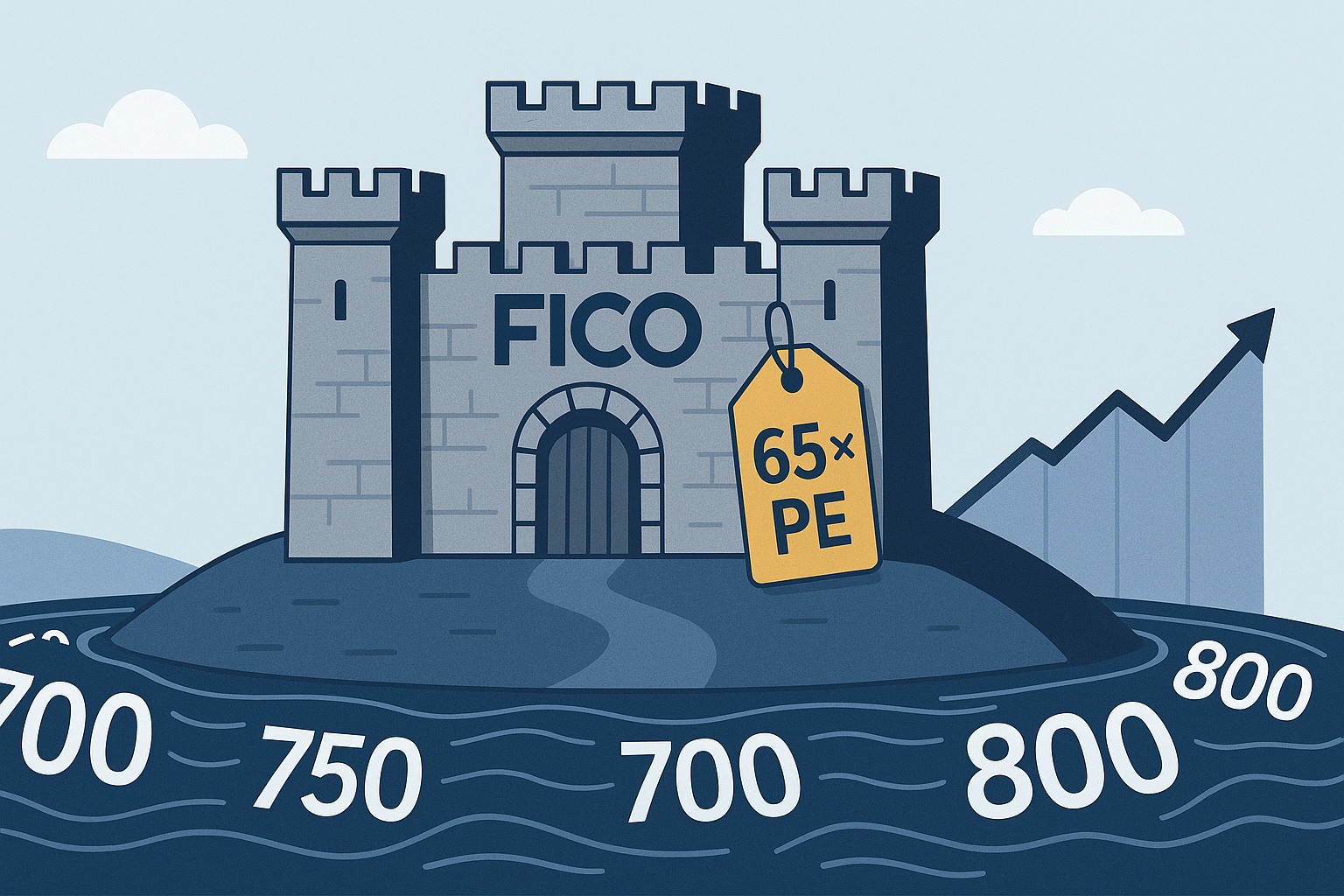The stock market has a certain elegance to its madness. Take Fair Isaac Corporation ($FICO) – down 16.5% year-to-date while the broader market parties on – now trading at what appears to be an eye-watering 65 times trailing earnings. Conventional wisdom suggests backing away slowly from such a valuation. Yet here we are, contemplating whether this might actually be... cheap?
Look, I've spent enough time on Wall Street to know that PE ratios are like carnival mirrors – they distort as much as they reveal. The question isn't whether 65x earnings is expensive (it is), but whether FICO's business justifies paying the premium. Sometimes the most expensive-looking stocks are hiding the best bargains.
The Credit Score Castle With an Expanding Moat
FICO scores are to credit what Google is to search – the default standard that alternatives have failed to dethrone despite decades of trying. When your product name becomes a verb ("Let me check your FICO"), you've built something special. The company has grown revenues 17% over the trailing twelve months, expanded operating margins by 400 basis points, and grown EPS by 34%. Not exactly the profile of a business in trouble.
What's particularly fascinating is FICO's pricing power. Their mortgage scores – about a third of their scoring business – have gone from $0.60 in 2022 to $4.95 today. That's an 8.25x increase in three years. When was the last time you saw a company raise prices by 725% without losing customers? This isn't a luxury handbag we're talking about – this is a critical financial infrastructure component.
The FHFA's attempt to blame FICO for rising home prices was almost comically misguided. The $4.35 price increase represents less than 0.1% of closing costs. It's like blaming the cost of the doorbell for making houses unaffordable.
The Direct Licensing Masterstroke
FICO's recent announcement of a direct licensing program is the kind of strategic move that should make investors sit up straight. Until now, the credit bureaus (Equifax, Transunion, and Experian) have been marking up FICO scores by 100% and pocketing the difference for essentially being middlemen. FICO's new model offers lenders two options: pay $4.95 per score plus $33 for each successful loan, or pay $10 for just the score.
This is brilliant in its simplicity. FICO creates a scenario where their worst-case outcome is maintaining the status quo, while their best case dramatically increases both revenue and margins. It's like watching a chess player set up a fork – no matter which piece the opponent moves, they lose something valuable.
Equifax's response – making VantageScore the same price as FICO and giving it away free for two years with FICO purchases – has all the strategic depth of bringing a spork to a gunfight. VantageScore has been trying to gain traction for two decades with minimal success. When you're underwriting loans worth hundreds of thousands or millions of dollars, saving $5 on a slightly less reliable credit score is penny-wise and pound-foolish.
The Interest Rate Tailwind
Here's where things get really interesting for FICO bulls. The mortgage industry has been operating at half capacity since interest rates spiked. Volumes are roughly 50% below their decade median. As rates come down (which they're finally starting to do), mortgage activity should normalize.
Given FICO's 90% EBIT margins on scores, a doubling of mortgage volumes would essentially double their profits in this segment overnight. Suddenly that 47x forward PE starts looking more like 23.5x. And that's before factoring in any further price increases or expansion of their direct licensing program.
Valuation: The Numbers Behind the Numbers
The market's current valuation implies a forward EPS of about $36, representing 20% growth from FY25's estimated $30. But this may actually be conservative when you consider:
- The potential doubling of mortgage volumes as rates normalize
- The margin expansion from direct licensing
- FICO's consistent ability to raise prices
- The company's strategic position as an essential financial infrastructure provider
A business that can grow EPS at 25% annually for the next decade – which FICO plausibly can – deserves a premium multiple. At that growth rate, earnings double roughly every three years. The apparent "expensive" 65 PE starts looking more reasonable when you realize you're buying a future 32.5 PE three years out, and a 16.25 PE six years from now.
The Bottom Line
Markets occasionally create these fascinating disconnects where the surface numbers (65x earnings!) mask the underlying value. FICO has built an essential business with extraordinary pricing power, expanding margins, and a fresh strategy to capture even more of the value they create. All while trading at a multiple that's actually come down substantially from recent peaks.
I know it feels counterintuitive to call a 65 PE stock "cheap," but sometimes the most obvious valuation metrics are the most misleading. FICO might just be one of those rare cases where paying up for quality turns out to be the bargain move.
But hey, I could be wrong. Maybe VantageScore will suddenly gain traction after two fruitless decades. Maybe lenders will decide saving $5 is worth risking hundreds of thousands in potential defaults. Maybe the housing market will never recover.
I just wouldn't bet on it.
